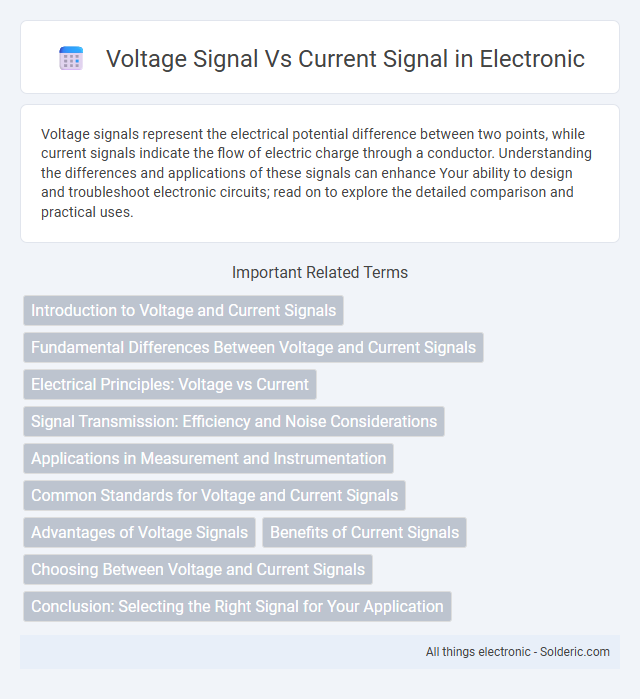Voltage signals represent the electrical potential difference between two points, while current signals indicate the flow of electric charge through a conductor. Understanding the differences and applications of these signals can enhance Your ability to design and troubleshoot electronic circuits; read on to explore the detailed comparison and practical uses.
Comparison Table
| Aspect | Voltage Signal | Current Signal |
|---|---|---|
| Signal Type | Voltage (Volts) | Current (Amperes) |
| Typical Signal Level | 0-10 V, +-10 V | 4-20 mA, 0-20 mA |
| Signal Transmission | Voltage varies relative to ground | Current remains constant; varies in magnitude |
| Noise Immunity | Lower, susceptible to voltage drops and interference | Higher, less affected by resistance or noise |
| Distance | Short distances recommended | Suitable for long cable runs |
| Load Impact | Load resistance affects signal accuracy | Load has minimal effect on signal |
| Power Supply | Requires separate power supply | Often loop-powered (no separate supply) |
| Applications | Low-cost, simple circuits | Industrial process control, sensors |
Introduction to Voltage and Current Signals
Voltage signals represent the electrical potential difference between two points and are commonly used to convey information in sensors and electronic devices. Current signals, measured as the flow of electric charge through a conductor, often provide more noise-resistant and accurate data transmission in industrial settings. Your choice between voltage and current signals depends on factors like distance, interference, and the sensitivity required for precise measurement.
Fundamental Differences Between Voltage and Current Signals
Voltage signals represent the electrical potential difference measured in volts, indicating the force that pushes electrons through a conductor, whereas current signals measure the flow of electric charge, quantified in amperes. Voltage signals can be affected by impedance and are typically easier to measure without influencing the circuit, while current signals require insertion of a sensing element, potentially altering circuit behavior. The fundamental difference lies in voltage being a driving force and current being the actual movement of electrons within an electrical system.
Electrical Principles: Voltage vs Current
Voltage signals represent the electrical potential difference measured in volts, driving current through a circuit, while current signals measure the flow of electric charge in amperes. Understanding the relationship between voltage and current is essential for analyzing circuit behavior, as voltage influences current according to Ohm's Law (I = V/R). Your ability to accurately interpret these signals ensures proper design and troubleshooting of electrical systems.
Signal Transmission: Efficiency and Noise Considerations
Voltage signals typically suffer from higher susceptibility to noise and signal degradation over long distances due to their dependence on potential difference, making them less efficient for high-noise environments. Current signals, often standardized at 4-20 mA in industrial settings, offer superior transmission efficiency by maintaining constant current flow, which reduces noise interference and voltage drop issues across transmission lines. This inherent noise immunity and consistent signal integrity make current signals preferable for accurate and reliable data transmission in harsh or electrically noisy environments.
Applications in Measurement and Instrumentation
Voltage signals dominate in measurement instrumentation due to their ease of transmission over long distances with minimal loss and noise interference, making them ideal for sensor output and data acquisition systems. Current signals, particularly the 4-20 mA standard, are favored for industrial process control because they maintain signal integrity despite resistance variations in wiring, ensuring accurate and reliable measurements. Both signal types are integral in automation, but choice depends on environmental conditions, distance, and noise susceptibility in measurement applications.
Common Standards for Voltage and Current Signals
Voltage signals commonly adhere to standards such as 0-10 V or 1-5 V, widely used in industrial control systems for precise measurement and control. Current signals typically follow the 4-20 mA standard, a robust range that minimizes electrical noise and allows for easy fault detection. Your choice between voltage and current signals depends on factors like transmission distance, signal integrity, and environmental conditions.
Advantages of Voltage Signals
Voltage signals offer higher immunity to noise and signal degradation over long distances compared to current signals, making them ideal for transmitting data in complex electrical environments. They require simpler and more cost-effective circuitry for measurement and processing, enhancing overall system reliability. Your choice of voltage signals can lead to improved system accuracy and easier integration with standard electronics.
Benefits of Current Signals
Current signals offer superior noise immunity compared to voltage signals, making them ideal for long-distance transmission in industrial environments. Your measurement system benefits from enhanced accuracy and reduced interference, as current loops are less affected by voltage drops or electromagnetic noise. This reliability ensures consistent data integrity in control and automation applications.
Choosing Between Voltage and Current Signals
Choosing between voltage and current signals depends on the application's sensitivity to noise and distance of transmission. Current signals, such as 4-20 mA loops, provide better noise immunity and consistent accuracy over long cable runs, making them ideal for industrial sensor data transmission. Voltage signals are simpler and cost-effective for short distances but are more susceptible to signal degradation and interference.
Conclusion: Selecting the Right Signal for Your Application
Choosing between voltage and current signals depends on the specific needs of your application, with voltage signals offering simplicity and ease of measurement, while current signals provide superior noise immunity and accuracy over long distances. Industrial environments favor current signals, such as 4-20 mA loops, for reliable transmission despite electrical interference. Accurate sensor data collection and control system efficiency rely on selecting the signal type best suited to minimizing signal degradation and maximizing system performance.
Voltage signal vs current signal Infographic

 solderic.com
solderic.com